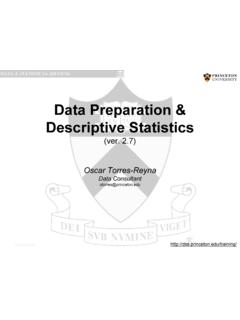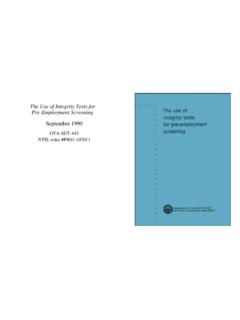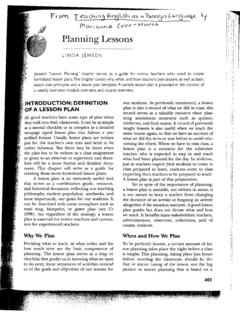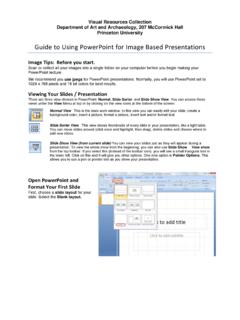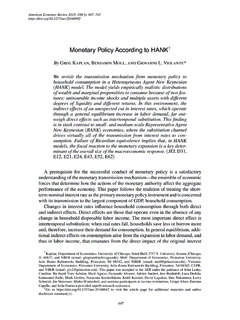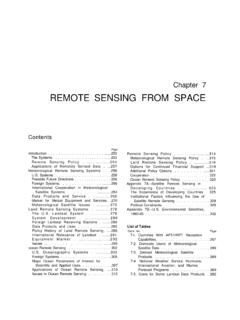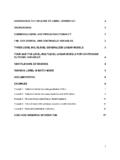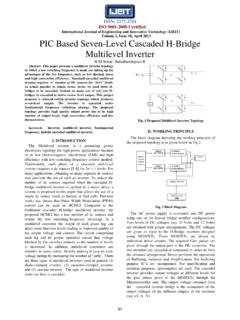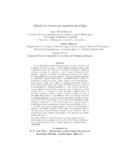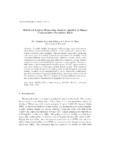Transcription of Multilevel Analysis - Princeton University
1 PU/DSS/OTRM ultilevel Analysis (ver. )Oscar Torres-ReynaData Multilevel model whenever your data is grouped (or nested) in more than one category (for example, states, countries, etc). Multilevel models allow: Study effects that vary by entity (or groups) Estimate group level averagesSome advantages: Regular regression ignores the average variation between entities. Individual regression may face sample problems and lack of generalizationMotivationPU/DSS/OTR3-40-2 002040y0204060schoolScorey_meanuse : egeny_mean=mean(y)twowayscatter y school, msize(tiny) || connected y_meanschool, connect(L) clwidth(thick) clcolor(black) mcolor(black) msymbol(none) || , ytitle(y)Variation between entitiesPU/DSS/OTR4statsbyinter=_b[_cons ] slope=_b[x1], by(school) saving(ols, replace).
2 Regress y x1sort schoolmerge schoolusing olsdrop _mergegen yhat_ols= inter + slope*x1sort school x1separate y, by(school)separate yhat_ols, by(school)twowayconnected yhat_ols1-yhat_ols65 x1 || lfity x1, clwidth(thick) clcolor(black) legend(off) ytitle(y)-20-100102030y-40-2002040 Reading testIndividual regressions (no-pooling approach)PU/DSS/OTRLR test vs. linear regression: chibar2(01) = Prob >= chibar2 = sd(Residual) .1030214 sd(_cons).
3 3999163 : Identity Random-effects Parameters Estimate Std. Err. [95% Conf. Interval] _cons .536272 .9193634 y Coef. Std. Err. z P>|z| [95% Conf. Interval] Log likelihood = Prob > chi2 =.
4 Wald chi2(0) = . max = 198 avg = Obs per group: min = 2 Group variable: school Number of groups = 65 Mixed-effects ML regression Number of obs = 4059. xtmixed y || school: , mle nolog5 Standard deviation at the school level (level 2)Standard deviation at the individual level (level 2)Mean of state level )()(_)(_)_()_()_(_222222222=+=+=+=residu alsdconssdconssdesigmausigmausigmancorre latioIntraclass An intraclass correlation tells you about the correlation of the observations (cases) within a cluster ( ) If the interclass correlation (IC) approaches 0 then the grouping by counties (or entities) are of no use (you may as well run asimple regression).
5 If the IC approaches 1 then there is no variance to explain at the individual level, everybody is the model (null)iijiy +=][Ho: Random-effects = 0PU/DSS/OTR6 Standard deviation at the school level (level 2)Standard deviation at the individual level (level 2)Mean of state level )()(_)(_)_()_()_(_222222222=+=+=+=residu alsdconssdconssdesigmausigmausigmancorre latioIntraclass An intraclass correlation tells you about the correlation of the observations (cases) within a cluster ( ) If the interclass correlation (IC) approaches 0 then the grouping by counties (or entities) are of no use (you may as well run asimple regression).
6 If the IC approaches 1 then there is no variance to explain at the individual level, everybody is the model (one level-1 predictor)LR test vs. linear regression: chibar2(01) = Prob >= chibar2 = sd(Residual) .0841759 sd(_cons) .3052516 : Identity Random-effects Parameters Estimate Std.
7 Err. [95% Conf. Interval] _cons .0238706 .4002258 .8082987 x1 .5633697 .0124654 .5389381 .5878014 y Coef. Std. Err. z P>|z| [95% Conf. Interval] Log likelihood = Prob > chi2 = Wald chi2(1) = max = 198 avg = Obs per group: min = 2 Group variable.
8 School Number of groups = 65 Mixed-effects ML regression Number of obs = 4059. xtmixed y x1 || school: , mle nologiiijixy ++=][Ho: Random-effects = 0PU/DSS/OTR7 Standard deviation at the school level (level 2)Standard deviation at the individual level (level 2)Mean of state level )()1()(_)1()(_)_()_()_(_22222222222=+++= +++=+=residualsdxsdconssdxsdconssdesigma usigmausigmancorrelatioIntraclassVarying -intercept, varying-coefficient modelNote: LR test is conservative and provided only for test vs. linear regression: chi2(3) = Prob > chi2 = sd(Residual).
9 0839482 corr(x1,_cons) .4975474 .1487416 .1572843 .7322131 sd(_cons) .3044138 sd(x1) .1205631 .0189827 .0885508 .1641483school: Unstructured Random-effects Parameters Estimate Std. Err. [95% Conf. Interval] _cons.
10 3978336 .6646554 x1 .5567291 .0199367 .5176539 .5958043 y Coef. Std. Err. z P>|z| [95% Conf. Interval] Log likelihood = Prob > chi2 = Wald chi2(1) = max = 198 avg = Obs per group: min = 2 Group variable.
